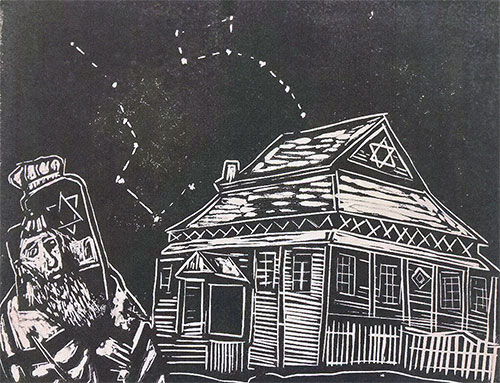Lost Treasures: The Wooden Synagogues of Eastern Europe The Artwork of Bill Farran
Vileyka, Belarus - Original Linocut
Vileyka, Belarus - Original Linocut
Yiddish: Vileyka
Polish: Wilejka
Vilyeyka was a small village when it became part of Russia as a result of the partition of Poland. Czarina Catherine II promoted the village to the status of a district town in the newly formed province of Minsk.
The first settlers in Vilyeyka were mostly Jews who lived in nearby villages and farms. Vilyeyka experience rapid growth in the 1880’s as Jews were expelled from rural villages and forced to relocate to towns. Another step in the advancement of Vilyeyka was the establishment of a railway station in the town along the new Shedletz- Bologoe line built in 1904. This was a big stride towards further development.
In 1860 there were three synagogues in Vilyeyka: the great Wooden Synagogue, the Beit Midrash of the Koidanow Hasidim, and the "Shtiebel" (small, informal house of prayer) of the Lubavitch Hasidim. During the first World War most houses and synagogues in the town were destroyed by fire. Most of the inhabitants left the town for fear of the Cossacks.
Vilyeyka was always a town of Zionist activity and as soon as World War I ended, Jewish youth renewed the activities that were forbidden during the years of the war. They flocked to the various Zionist organizations and groups. Many young were trained and prepared for Aliya to Eretz Israel.
During World War II, the Nazis destroyed all Jewish life in Vilyeyka.
Purchase a print
Original linocut prints are 8x10 inches, and are available either unmatted or in an 11x14 matte.
I also offer matted 5x7 digital prints. These prints are created from high-res digital images and come in an 8x10 matte.
